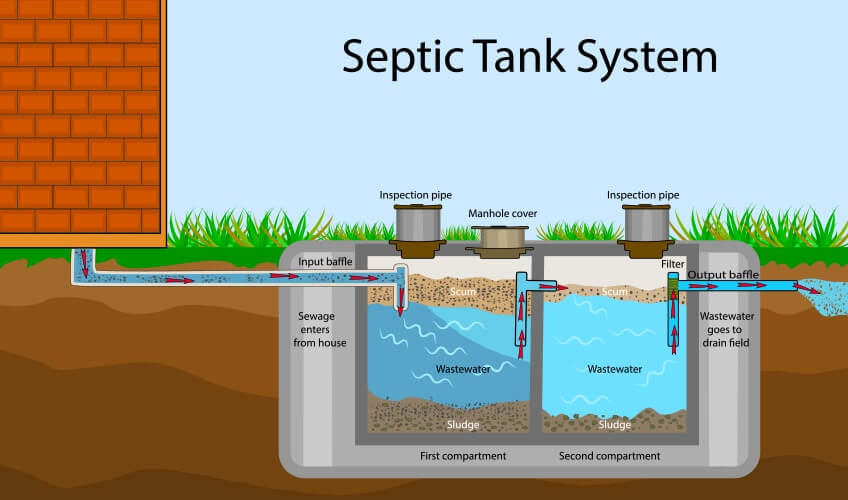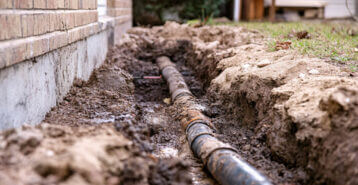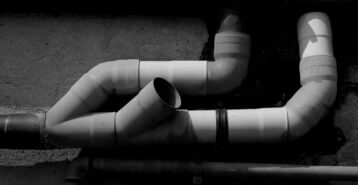Septic Tank Installation: Costs by Type, Installation & More
When you live in a rural area, you might not have a municipal sewer line that is close enough to connect to your home. In that case, you will need a septic tank system to handle the wastewater that is generated in your home. Septic tanks are where all the waste from your home is channeled. The septic system separates the solids and the water, filtering the water and reintroducing it naturally into the environment.
Since this is a significant purchase and one that requires permits, professional installation, and regular inspections, it pays to know what you’re getting into before you buy or build a home that needs a septic tank.
Types of Septic Tanks
There are numerous septic tank options, including those made of plastic, concrete, fiberglass, and stainless steel. There are also different types of systems, such as aerobic or anaerobic. There are some slight differences in price for these tanks and types. In addition to the costs for these tanks, there is also installation to consider.
How Much Does Septic Tank Installation Cost?
The cost of a septic tank installation typically runs between $1,500 and $4,000. This is dependent upon the complexity of the install, the area of the country you are in, and the type of system and tank you choose.
Initial Purchase Cost
The purchase cost of the tank itself can run around $800 or so for a plastic tank and up to $6,700 or so for a concrete tank. This cost might not include the preparation work, creating the leach field or drain field, and additional components.
Installation Cost
Installation costs only will run a national average of $160 per hour, but keep in mind that cost might be higher or lower depending upon your geographical area. Labor costs might go up with a more complex installation. You will likely also have additional costs to hire heavy equipment for digging and placing the tank, though some contractors roll these costs into their labor fees.
Maintenance Costs
Maintenance for a septic tank is a must — in fact, most areas require an annual inspection. This inspection usually runs between $100 and $200. It often also includes a pump-out of the tank, which helps ensure it doesn’t overflow before your next annual inspection rolls around.
Factors Affecting Septic Tank Installation Cost
Now let’s dive into the nitty-gritty of your septic tank cost. This includes materials, the size of the tank, the type of system, the additional components, and more.
Tank Material and Size
Since a cracked or broken septic tank can wreak havoc on the environment, only certain materials are approved to use when creating a septic tank. The most common materials include:
- These are the most common tanks. They last for an average of 20 years. Eventually the concrete will erode and crack, leading to liquid seeping out of the tank, which is why yearly inspections are so important.
- These tanks resist rust and corrosion, as well as cycles of expanding and contracting with freezing temperatures. If the ground shifts or the water table gradually changes, the fiberglass tanks can move, which can throw off the whole system.
- Plastic tanks are a lightweight option that resists rusting and cracking. They are also much easier to install. However, the lighter weight means they can rise through shifting ground or break if there is an earthquake or other seismic event.
- Though these tanks have a 20-year lifespan, most of them break down well before that thanks to rusting and corrosion. Due to this, most contractors will steer homeowners away from stainless steel.
| Material | Average Cost |
|---|---|
| Concrete | $2,350 to $6,750 |
| Fiberglass | $1,600 to $2,000 |
| Plastic | $830 to $1,900 |
| Stainless Steel | $1,000 to $1,200 |
The size of your house helps determine what size tank you need and that determines some of your costs. A good rule of thumb is that a 3-bedroom home will need a 1,000 gallon tank. That costs an average of $600 to $1,000. A tank of 3,000 gallons can accommodate a very large family and runs between $2,900 and $3,900.
Installation Complexity
For some lucky homeowners, installing a septic tank is very straightforward. There’s plenty of room, the land is easy to dig into, and there’s little guesswork. Other homeowners aren’t as lucky. What can turn a relatively easy job into something more complex?
- Landscape prep. The land has to be able to handle the weight of the septic tank as well as the water that will be flowing out of it. After the testing is done and it is determined that you can place a septic tank where you want, enterprising homeowners can work on digging the hole for the tank and the trenches themselves. Having a professional handle this runs between $1,500 and $4,500. That price goes up if boulders and other impediments must be removed.
- Soil testing. A percolation test done by a licensed engineer is a requirement to obtain permits for the septic tank. Expect this testing to cost between $1,000 and $2,000.
- Leach field. This comes with many variables, such as the size, soil content, and more. Expect to pay between $2,000 and $10,000 for installing the leach field to accompany your septic tank.
Permits and Inspections
In almost every area, a permit will be required to install a septic tank. Your contractor can handle this for you as part of the job. That permit usually runs a few hundred dollars, though it might be higher in areas that face ecological threats and thus must be much more thorough in their permit process.
Inspections are recommended on an annual basis. In most cases this inspection must be reported to the municipality where the tank is, so that officials know which tanks in the area are in need of or repair or replacement. An annual inspection can run between $100 and $200 for a straightforward system.
Geographic Location
The going rate for labor in your area will determine part of the quote for your septic tank installation. Areas near metro areas will likely cost a bit more than areas that are further out in the country. You will also have to take into account the differences in the land — for instance, the soft soil near the Mississippi River will make it much easier to install a septic tank than the boulder-filled areas in eastern Pennsylvania will. The more difficult the job, the more expensive the work will be.
System Type
The type of system you choose can bring a different cost to your bottom line. Here are some of the more common types to choose from:
- This tank allows the waste to settle at the bottom and the liquids to rise to the top. As this happens, the liquids are drained through pipes into the drain field, where they are processed back into the earth.
- These systems are among the more affordable. They rely on bacteria that hate oxygen to naturally break down the waste that flows into the tank.
- On the other hand, this type of tank pumps air into the waste to encourage growth of bacteria that love oxygen. That bacterium then breaks down the waste.
- This is for those homeowners who don’t have soil well-suited to handle a drain field. In that case, they must build an artificial drain field with perforated tiles and a biofilm. This extra work creates a “mound,” thus the name.
- Sand Filter. This system uses a pump to push the waste to the filtration system of sand-filled pipes. This creates a natural filter that purifies the wastewater before it reaches the water table.
- Pressure Distribution. This allows you to install a septic tank within two feet of the water table by pushing waste into the drain field quickly via pump. This allows for quick process of the waste.
| Type of System | Average Cost |
|---|---|
| Conventional | $3,500 to $10,000 |
| Anaerobic | $2,000 to $5,000 |
| Aerobic | $10,000 to $20,000 |
| Mound | $12,000 to $17,000 |
| Sand Filter | $6,000 to $10,000 |
| Pressure Distribution | $7,000 to $10,000 |
Additional Components
Other components necessary for your septic tank to work properly will be included in your costs. These can include things you must have, such as a distribution box, but they can also include pumps, alarms, robust baffles, and much more. As your septic tank ages, you’re going to need replacement parts.
Here are a few common components that might run up your costs.
| Component | Average Price |
|---|---|
| Baffles | $300 to $500 |
| Pump | $800 to $1,400 |
| Tank Lid | $30 to $70 |
| Tank Filter | $230 to $280 |
| Drain Field Replacement | $6,000 to $7,000 |
Contractor Fees
In most cases, the labor fees for the septic tank installation will be spelled out in your quote. Look for this as a line item and break it down to see what the hourly rate is (if the contractor doesn’t provide that for you). If the fees on a quote are much lower or higher than the others, ask for an explanation. Sometimes you’ll find that a higher labor cost means you don’t pay for the rental of heavy equipment or other factors that affect the bottom line.
To get a good baseline, remember that the national average for installation of a septic tank is $160 per hour.
DIY vs. Professional Installation
In most cases, professional installation of a septic tank is highly recommended. In fact, some areas require that a professional install the tank and any components — there are permit requirements that must have the name of a professional contractor listed for the septic tank to be considered safe and environmentally-friendly.
Besides that, installing a septic tank requires some serious heavy machinery to dig the appropriate area or move the tank itself — that’s not something a typical DIY homeowner can do.
There are plenty of areas where you might be able to do things on your own for your home, but installing a septic tank is not one of them.
Cost-Saving Tips
Septic tanks can be expensive enough that it becomes tempting to cut corners to save some money. But the fact is that a septic tank will be relied upon for many years, and you want to make sure it is up to the task. However, there are some ways you can save money on your septic tank and installation:
- Get several quotes. The more quotes you have, the better a feel you will get for your local labor costs. Make sure that your quotes compare apples to apples; for instance, a quote for a plastic tank can’t really be compared to another quote for a concrete tank.
- Choose the right type. Having the right type of septic system can save you a great deal of hassle down the road. Make sure of what you’re getting and ask a professional to help you decide.
- Learn everything about your system. Understanding your system and how it works will help you spot problems early, which can save you money when it comes to repairs.
- Don’t neglect regular maintenance. Don’t fall behind on your annual maintenance schedule. If there is maintenance you need to do yourself between visits from the pros, create a calendar reminder to make sure you do it. The better you care for your system, the longer it will last and the fewer problems you’ll have to pay to fix.
Conclusion
Understanding the factors that play into your septic tank installation cost can go a long way toward helping you find the best possible options. From choosing the right size tank for your home to making sure the components are all in good working order, there are many ways to turn this rather hefty purchase into one you feel really good about.
Compare top-rated plumbing pros in your area.
Read real homeowner reviews, explore qualifications, and view promotions. Modernize makes it easy to browse professionals and find one that will be perfect for your project.







